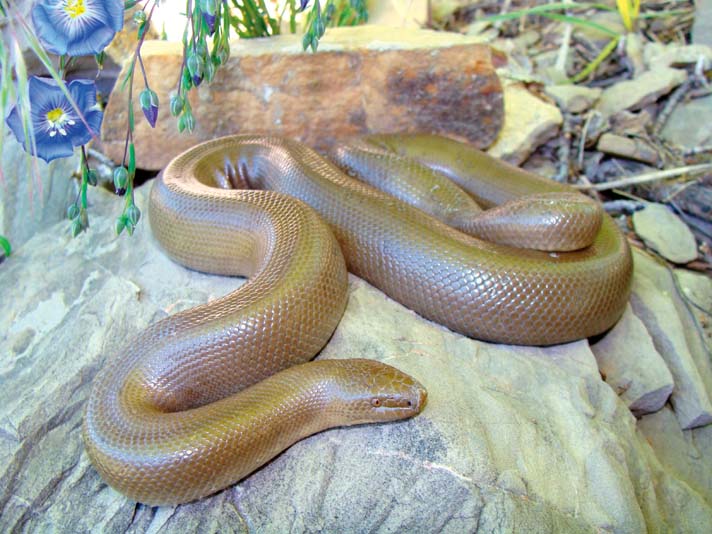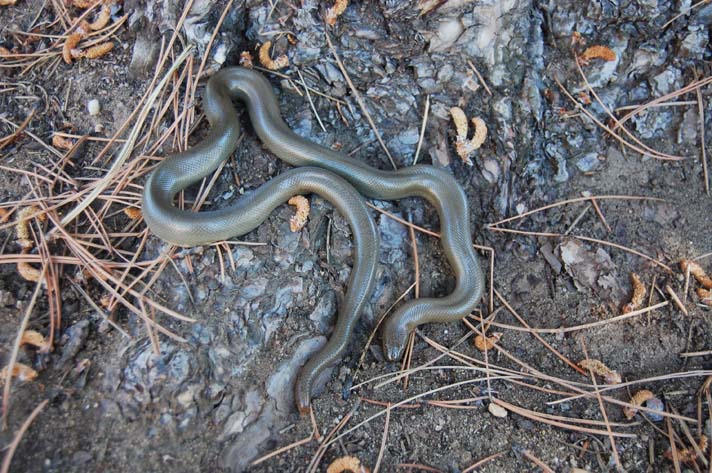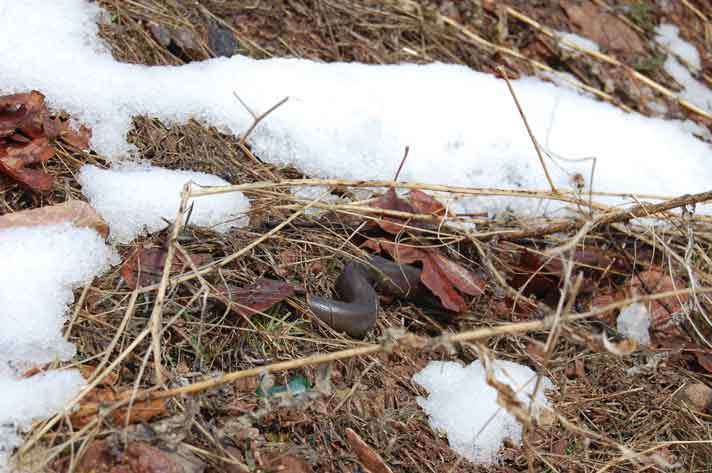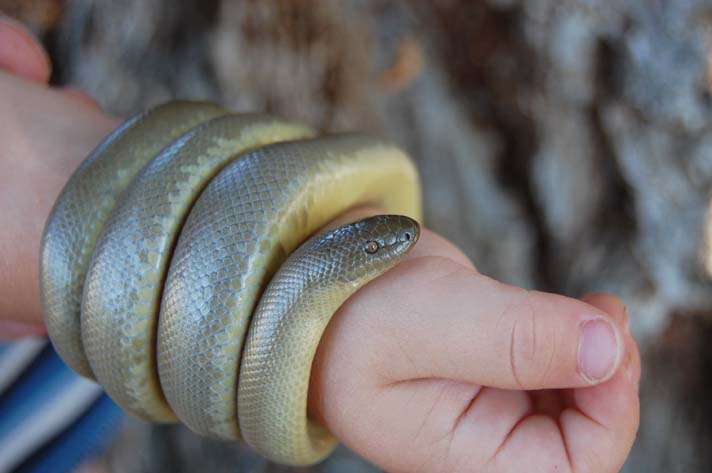This native North American differs from other snakes in some interesting ways.
The life of a rubber boa (Charina bottae) happens at a bit of a slower pace than it does for most snakes. This laid-back, gentle species is too often misunderstood when it is compared to more commonly kept species. What the rubber boa may lack in coloration, it makes up for in personality, and it is because of its calm and passive nature that I find the rubber boa such a delight to interact with. Specimens are slow and gentle, and they almost seem to appreciate being held. Having kept more than 20 snake species in captivity, I have found none to be as enjoyable to maintain as the rubber boa.
Rubber Boa Range and Description
The rubber boa is native to the western United States and British Columbia, Canada. It can be found in a wide range of habitats, from sea level to more than 8,000 feet, and from dry desert sagebrush landscapes to high-rainfall areas of western Oregon, Washington and BC.

Matt Jeppson/Shutterstock
The natural range of the rubber boa is the western United States and British Columbia.
This is not a very large snake. In many regions, adult male rubber boas average about 18 to 21 inches in length and weigh up to 80 grams. Adult females are larger, averaging approximately 23 to 26 inches, and usually more robust, sometimes exceeding 200 grams.
It is presumed that the common name is derived from both its plain coloration, similar to that of natural rubber, and the soft, pliable nature of its skin, which is in part due to the smaller-than-usual, unkeeled scales. The tail is unusually blunt for a snake, and may be mistaken for the head to an untrained eye.
The tails of wild rubber boas are sometimes highly scarred. For most of the boa’s recorded history, it was believed that the shape of the tail and the scarring were the result of the tail being used as a predatory defense. This may be true in part, because when threatened the boa may form a ball with its head protected inside its body coils and the tail exposed as a false head. However, this does not adequately explain how such a defense would protect the rubber boa from predators that are likely to kill it (e.g., hawks, coyotes and weasels). Such a strategy would be useless against most any predator that would kill and eat a rubber boa.
In laboratory feeding trials, one of the authors (Richard) observed boas preying on nestling mice while keeping the mother mouse at bay with “false strikes” of its tail flipping back and forth. The adult mouse would focus its attention on attacking the tail, while the boa would focus on consuming the nestlings. It would seem that this would account for some of the scarring observed on the tails of wild boas.
More Rubber Boa Information
A rubber boa’s natural diet is primarily nestling rodents, but it will readily consume native lizards and their eggs, as well. In captivity, a diet of mice is well suited for a rubber boa’s entire life span, which can be quite long. A number of wild rubber boas have been recaptured over a period in excess of 20 years, with some specimens being large, older adults when first captured.. The oldest known rubber boa was first found in June 1971 as a large and aged adult at that time (a minimum of 20 years old already, and likely much older), and it lived until June 2006. So this boa was at least 50 years old and quite likely much older than that.
Finding Rubber Boas
Rubber boas are not commonly bred in captivity perhaps due in part to the fact that some states in which rubber boas occur do not allow residents to breed wild-caught specimens. Or this may be a result of a lack of appreciation on the part of hobbyists and breeders. Most of the captive rubber boas I’ve encountered were wild caught, although there are a few people who breed them, and rubber boas do turn up in classifieds listings from time to time. I don’t believe any state where rubber boas occur allows for commercial collecting, but most do permit some form of recreational take.

ryan hoyer
Rubber boas are known to live for a long time. The oldest known specimen may have been 50 years old.
April, May and June are the most common months to encounter rubber boas in the wild, when temperatures are moderate in the areas where the boas live. It is possible to find them surface-active during the day, but rubber boas are generally light sensitive and only infrequently can be found in the open during the daytime. More often, they are encountered crossing hiking trails in afternoon shade, or at dusk.
Once the weather warms and dries out, rubber boas spend much of their time underground, emerging only at night. Road cruising is one possible strategy to find them at this time, but it is not as effective as it is when searching for other snake species.
The Ideal Rubber Boa Enclosure
The captive care of a rubber boa is largely similar to that for most species of snake. I have successfully kept them in aquariums, custom and commercial sweater box racks, and other custom caging. A young rubber boa can be kept in a 10-gallon aquarium or enclosure of comparable size. Large adult females can be kept in a 20-gallon long aquarium or a sweater box measuring 15 by 21 inches.
As long as the caging is highly secure, almost any type will work well. You must ensure that the caging is secure, with no possibility of escape. Numerous people have contacted me regarding a newly found rubber boa, which they placed in a cage that would be perfectly adequate for a similarly sized corn snake or milksnake, only to have the rubber boa escape. Rubber boas are quite adept at getting out of cages, and I cannot overstress their talent for finding any wiggle room or flexibility in a cage lid and slowly squeezing their way out over the course of several hours.
Although many snakes spend much of their time hiding, the rubber boa sometimes takes this to an extreme. In the wild, they are largely fossorial, right at home in dark and tight spots underground. As it is a relatively slow-moving species, the rubber boa is rarely found above ground during the day, where it would be exposed to predators it could not escape. In captivity, this translates to a rubber boa wanting to remain snug in secure hiding spots most of the day. If your pet rubber boa is out wandering during the day on a regular basis, this suggests it is stressed and unable to find a hide spot to its liking.
Half-hollow logs or similar open hides are less than ideal, as these will not provide the security that a rubber boa seeks. Most of the hides I use are simple, even if not very aesthetically pleasing. An overturned clay pot saucer with a notch out of the rim works very well. Even something as simple as a small stack of folded newspapers is preferred by rubber boas over something more roomy and open.
Although rubber boas can be found in arid environs, they are subject to rapid dehydration. Their skin is more permeable to moisture than many species. Of course, like most snakes, fresh water should be provided at all times. While not necessary, a hide with damp moss will likely be appreciated, and if adequately secure and dark, it will be used often.
There are a few substrates that do not work well with rubber boas. Very fine substrates and very coarse substrates can both cause problems due to the rubber boa’s tendency to burrow. I’ve also been contacted by people who kept their boas on large bark pieces, resulting in the snakes’ rostrum and other head scales becoming badly abraded. For this reason, large bark pieces, coconut husk chips and the like are not recommended for use with rubber boas.
Any substrates that contain sand or fine particles of dirt should also be avoided. Their use is the most detrimental mistake I have observed in the keeping of captive rubber boas. As a rubber boa burrows, fine substrate particles will get into its mouth, and may also cause blockage of the sinus passageways, leading to an infection of the sinuses. While I cannot directly attribute this malady to the use of coconut coir, I still discourage its use with rubber boas because I have seen it get into their mouths.
I have regularly used both shredded aspen and kiln-dried pine shavings. Both allow the snakes to burrow, and are comprised of sufficiently large particles so as not to cause any problems such as described. They also lack the roughness that might otherwise damage the snakes’ scales. Shredded aspen has the added benefit of holding its form well, allowing rubber boas to make tunnels throughout the substrate.
Rubber Boas Are Cold Tolerant
Rubber boas do not tolerate high temperatures; a body temperature in the low 90s Fahrenheit can be fatal to them. I have provided gravid females a full range of temperatures from which they could choose, and they consistently chose to incubate their young in areas where their body temperature would be 83 to 85 degrees. From this and other observations, I concluded that the warm end of a rubber boa enclosure should not exceed 85 degrees. The cool end can be as low as 65 degrees during the active season, although I commonly keep rubber boas at an ambient temperature of 70 to 75 degrees all summer long. Digestion takes place just fine at these temps, and no hot spot is necessary.

ryan hoyer
This photo demonstrates the rubber boa’s unusual tolerance for cold—this one was encountered among patches of snow!
Two field observations of mine highlight how much rubber boas differ from other snakes when it comes to tolerating the cold. Both were made at a Utah location where I have routinely observed male rubber boas in February. The first was on a bright, sunny day in early February, when the previous night’s low was well below freezing, about 24 degrees. With the air temperature just above freezing, I observed a few male boas sunning themselves in the mid-morning sunshine. At the same location a few years later, this time in late February and two days after a snowstorm, I observed a few male rubber boas sunning themselves. One even had a patch of snow touching its body!
Such observations are not typical, and it must be recognized that the south-facing angle of the Utah location allowed the rubber boas to be warmed by the sun despite the temperatures. However, they do illustrate how rubber boas will tolerate conditions that other snakes will not or cannot. I have also observed rubber boas crawling in an enclosure with temperatures in the low 40s, apparently searching the cage for a better spot to overwinter.
Originating from climates with cold winters, rubber boas have a strong tendency to brumate over the winter. Although it does not appear to be required to brumate captive rubber boas for health reasons, if they cease feeding in the late summer or early fall, it is advisable to follow their natural tendency and cool them for the winter. Wintertime brumation temperatures do not need to be extreme, even if the snakes can withstand temperatures at or just below freezing. Brumation at 55 degrees would be adequate.
Feeding Rubber Boas
As mentioned previously, a diet of mice is perfectly fine for any rubber boa, regardless of size or age. Some people worry that baby rubber boas, which weigh less than 10 grams and have a diameter smaller than a pencil, couldn’t possibly eat pinky mice. They can, though, even if it may require a little bit of a stretch. The issue is not the capability, however, but the willingness of a rubber boa to accept lab mice.

ryan hoyer
Handling a rubber boa is not usually problematic; this species is usually quite gentle and passive.
It is my personal theory that lab mice (Mus musculus) simply don’t smell like food to rubber boas. Their most common native prey—deer mice (Peromyscus), voles (Ellobius) and lizards (primarily Sceloporus)—generally will be readily consumed by young rubber boas or newly wild-caught boas, but they will often refuse to take lab mice. However, after they are once enticed to eat a lab mouse via scenting, braining, washing or some combination thereof, rubber boas are far more likely to readily accept lab mice from then on out.
It should be noted that in the wild, babies are born late in the summer or early fall, and in the latitudes and elevations where they reside, cool weather has already arrived. It appears to be normal for newborns to overwinter where they were born, never taking a meal until late the next spring or early summer. While I have had newborns take food shortly after birth, it is more common in my experience that they will refuse food until the following spring, especially if they were born later in the year.
In fact, I have had newborns refuse to eat during the first spring and summer of their lives, and enter their second brumation without ever having eaten a single meal. As a result, they did not eat their first meal until after they were 18 to 20 months old! Such long periods of survival likely would not be possible if cooler temperatures were not the norm, including a lengthy brumation period of four or five months. Had these baby boas been kept at 78 to 80 degrees as I do neonates of other species, their metabolism would have been higher, and they may not have survived long enough for them to decide to take their first meal.
I had one wild-caught adult female rubber boa that refused to take any food for more than two years. I never force-fed her and remained patient, taking regular weights to monitor her health. In order to wait her out, I brumated her in the winter and did not allow her cage’s ambient temperature to exceed 75 degrees during the summer. While she did lose significant weight during this period, she remained healthy with ample fat reserves and good muscle tone. She did eventually decide to eat voluntarily, and was a great eater after that. Other rubber boas I’ve kept have not gone quite so long as this stubborn lady, but they have come close.
As a rule, most male rubber boas almost always will refuse to take any meals until late spring or early summer, after the breeding season. Several of my males feed only during June, July and perhaps the first part of August. Others continue eating until September. The remaining months of the year, they fast, refusing to take any meals despite any environmental manipulations I have tried. It is simply in their nature, likely part of a species survival strategy, to only feed after the mating season, when gravid females are fasting during gestation and with prey being more plentiful.
As you can see, the rubber boa is not your typical snake when it comes to feeding. It is far more patient in its approach to eating, often taking its time to thoroughly smell the prey prior to gently starting to eat it. Rubber boas rarely strike in the manner that most snakes will to take their prey, and even shy away from prey that moves fast. In the wild, the rubber boa is adapted to robbing nests of rodents, preying on the non-mobile babies.
So, if you have a rubber boa, and you are stressing because it is not eating like other snakes, don’t sweat it so much. Take a lesson from the rubber boa, and try to take life at a more relaxed pace.
Ryan Hoyer grew up around rubber boas and has kept them continuously for 20 years. His website, rubberboas.com, shares much of his father Richard’s rubber boa knowledge that has not been otherwise published. Richard Hoyer has been studying the rubber boa for more than 50 years, resulting in the publication of several peer-reviewed journal pieces based on his work.


